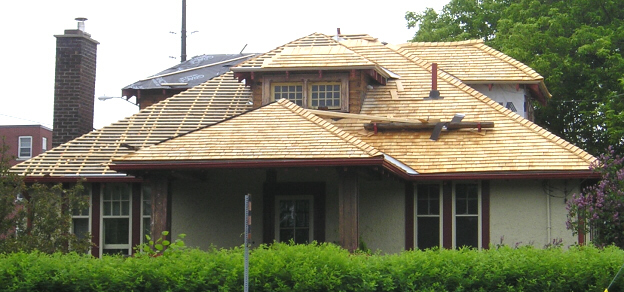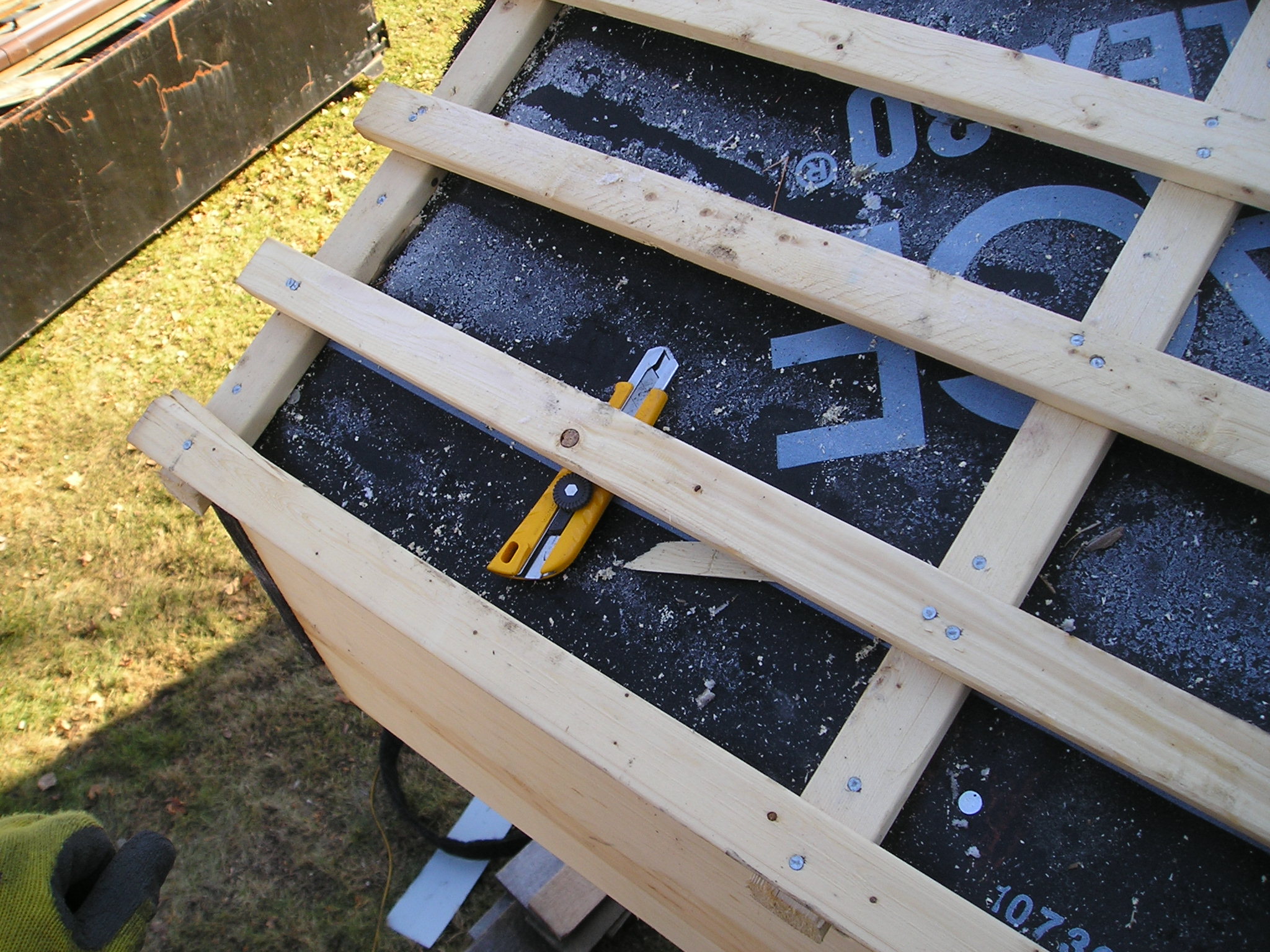Cedar shingles are a cost effective roofing choice as their durability is so great in comparison to other roofing products. While steel roofing is a wise choice in its own right, the colour tends to fade as the steel ages. Additionally, due to expansion and contraction as a result of temperature changes, steel can fail at the screws, and other stress risers, due to metal fatigue. Asphalt shingles do not even come close to the durability of cedar shingles. I have rarely seen an asphalt shingle roof even approach the life of its warranty. A properly installed cedar shingle roof can last from 60 to 80 years.
Cedar shingles have been used for centuries. I have seen some indication that they have been used since the 1600's. I have seen patent registrations in the United States Patent Database for shingle equipment patents as early as 1800.
The most recent patent date on my first shingle mill is 1883. It was manufactured by the Hamilton Machine Company in Peterborough, Ontario. I would suspect, looking at the frequency of the patents on that machine, it was manufactured close to that date.
Within the last 60 to 70 years, asphalt shingles came onto the market. I can understand the success of this product. Being that the upfront cost of the asphalt shingles is inexpensive and install time was greatly reduced in comparison to cedar shingles. Unfortunately, the inexpensive upfront cost of asphalt comes at the price of durability of the product and potentially the integrity of the structure when they fail.
Steel roofing products have been available for a great many years in various profiles including; panels, standing seam, and sheets. Within recent years, the finishes of these products seems to have improved. To the credit of the manufacturers, they have invested in material handling equipment that allows customers to order materials cut to length, thereby reducing the labour required during installation.
Cedar shingles are still used for their traditional purposes of roofing and siding. Their use is not as common due to products that require less labour and are ultimately less expensive upfront. The loss of installation knowledge over the last several decades has also contributed to a shorter life expectancy and therefore contributed to an erroneous poor reputation for the product.
Cedar shingles are still used for their traditional purposes of roofing and siding. Their use is not as common as in the past due to products that require less labour to install and are ultimately less expensive upfront. The loss of installation knowledge over the last several decades has also contributed to a shorter life expectancy of cedar shingles and therefore contributed to an erroneously poor reputation for the product.
I have seen several old buildings with cedar shingles that have functioned without leaks for 8 decades. My father has a barn that has performed that well. My father's barn roof is definitely in need of replacement now. Who has a right to complain after so many years of service?
In marketing my shingles, I have found several arguments against them. A search of the Internet will find some awful experiences some people have had: Roofs failing after 20 years; shingles cupping and curling; shingles rotting prematurely; shingles cracking and breaking prematurely; I have found accusations on the Internet where it is the fault of the second growth cedar. Direct experience in marketing the shingles has yielded some of the same stories.
I look at that barn roof and see the length of time it had lasted and question why the shingles aren't working the way they should. Why are there stories such as these? As cedar trees go, they quite probably haven't changed much in the last 10,000 odd years, much less in the last hundred. The fungi that breakdown the wood have changed far less than the wood itself. What has changed?
Only the installation practices have changed in the last 30 or 40 years. It is the current practice to nail the shingles directly to the deck with inter-woven tar paper in successive courses. It is my opinion that this practice is deficient.
When rain falls on asphalt or steel roofing, the water immediately runs off. The reason for this is that the saturation point of asphalt and steel is so low, or non-existent. With cedar shingles, the material is natural and therefore has different properties. When rain falls on a cedar shingle, the wood absorbs enough water to reach its saturation point before running off.
At first hand this, characteristic of cedar shingles, may raise an eyebrow and the question; ‘Is this a good thing?'. However, due to this absorption, small defects and holes, particularly around the nails swell shut as the wood expands. This characteristic is the same as in wooden barrels and to a lesser degree in wooden boats. This property of expansion in relation to water saturation must be accounted for in the installation of the shingle as well. Each shingle must be gapped from its neighbour by roughly 3/16".
While the expansion due to water of the wood is a good thing in the roofing when it is raining, maintaining the high moisture content of the wood on a long term is not. Care must be taken during installation to allow this moisture to escape from the cedar shingles to prevent fungus growth.

In observing cedar shingle roofs over the years, coupled with an understanding of wood, and listening to the old-timers, I have noticed the practices for installation cedar shingles are deficient. The practice of interweaving felt paper in successive courses cuts the life of the shingle. Nailing cedar shingles directly to the roof deck has the same effect.
Cedar shingles are a natural wood product. All woods have properties and considerations that must be adhered to, to gain their full life expectancy. As water falls on a cedar shingle roof, the shingles will saturate with water before they run off. It doesn't take much water to saturate them. However, if the shingles are nailed directly to the deck or with interwoven tar paper, they will dry on the exposed face first. This creates a moisture differential which causes cupping in the shingle. These additional stresses caused by the working of the wood will eventually break the shingle.
Additionally, with the shingles nailed directly to the deck with interwoven tar paper, moisture is trapped in the shingle providing for an ample opportunity for fungus growth. Nailing the shingles directly to a solid deck with or without interwoven tar paper is the same as throwing a piece of wood on the ground; in 5 years it will be rotten.
The difference between the shingles installed on my father's barn and the current common practice for installing cedar shingles is ventilation. The shingles on the barn have ample opportunity to dry evenly, where the current common practice does not.
In some locations, particularly with split shakes, and hard driving winds, interwoven tar paper may be the best practice. In the case of a sawn, relatively smooth shingle, inter-woven tar paper is not a wise practice.
To provide for the ventilation to remove moisture from the shingles, there are four elements to build into the roof:
1. Roofing underlayment: This material, 15# felt, Tri-Flex or Ice / Rain Guard is applied to the deck of the roof ( mostly to keep the code happy )
2. Strapping grid: strapping is nailed in a vertical orientation from eve to ridge on 16" or 24" centres to match the rafters; Then strapping is nailed on centres equal to shingle exposure in a horizontal orientation.
3. The shingles are nailed to the horizontal strapping.
4. Venting: A continuous vent is built into the perimeter, where possible, using a double run of shingle starter or double facer boards. Material such as GAF Cobra rolled ridge vent, or Duraflow Rolled Ridge Vent, is cut into strips and installed in the gaps of the double facer or shingle starter.
By building these elements into your cedar shingle roof, the excess moisture should be evacuated from the back of the shingle.
The grade of shingle you use will have an effect on the life of the roof as well. When the nay sayers target young wood they are not completely incorrect. Care must be taken to exclude sapwood from the roof. Sapwood does not have the natural preservative properties of the heartwood in cedar. Sapwood will rot first.
When you purchase your cedar shingles, be certain to purchase graded shingles. The grades may be to the specification of a government or industry body or simply that of the mill. Point being, is for you to know what you are purchasing. A roofing grade single must have; the sapwood excluded from 2/3rds of the shingle from the butt; additionally, reaction wood must be excluded; large black knots should not appear on the bottom 2/3rds of the shingles; checks and cracks should not appear on the bottom 2/3rds of the shingles; a pin knot on the face may appear without degrading the shingle. the shingles in a bundle should not have more than 5% of the shingles being less than 3" wide; pitch pockets should not appear in the bottom 2/3rds of the shingle; If you are unable to purchase graded shingles, be certain to take this into account in the price.
Care must also be taken when purchasing your shingles. I have become aware of some mills that are selling their shingles based on a double coverage. Therefore, they will sell a bundle of 16" shingles covering 25 square feet at 8" of exposure. Best practice however, is for a triple coverage. A bundle of 16" shingles should cover 25 square feet at 5 3/8" exposure. Regardless of whom you should purchase your shingles from, be certain to take the coverage at a given exposure into account. If you do not, you may find your material costs to be considerably greater than expected or left with a roof that is inferior to what you had expected.
